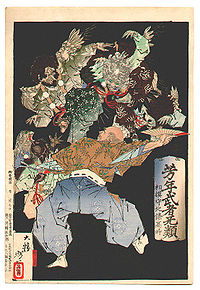
Hojo Takatoki
Encyclopedia

Tokuso
Tokusō was the title held by the head of the mainline Hōjō clan, who monopolized the position of shikken of the Kamakura shogunate in Japan....
and ruling Shikken
Shikken
The was the regent for the shogun in the Kamakura shogunate in Japan. The post was monopolized by the Hōjō clan, and this system only existed once in Japanese history, between 1203 and 1333...
(regent) of Japan's Kamakura shogunate
Kamakura shogunate
The Kamakura shogunate was a military dictatorship in Japan headed by the shoguns from 1185 to 1333. It was based in Kamakura. The Kamakura period draws its name from the capital of the shogunate...
; the latter ones were his puppets, a member of the Hōjō clan
Hojo clan
See the late Hōjō clan for the Hōjō clan of the Sengoku Period.The in the history of Japan was a family who controlled the hereditary title of shikken of the Kamakura Shogunate. In practice, the family had actual governmental power, many times dictatorial, rather than Kamakura shoguns, or the...
, he was the son of Hōjō Sadatoki
Hojo Sadatoki
was the ninth shikken of the Kamakura shogunate , and Tokuso from his appointment as regent until his death....
, and was preceded as shikken by Hōjō Morotoki
Hojo Morotoki
was the tenth Shikken of the Kamakura Bakufu.- References :...
.
Takatoki became regent at the age of eight, and thus actual power was held for a time by Adachi Tokiaki, his grandmother, and Nagasaki Takasuke, a minister assigned to him. Takatoki fell ill in 1326, at the age of twenty-three, some time after having taken power himself; the shogunate was under attack at this time, and would fall within a few years. Takatoki retired and became a Buddhist monk, though he still held some influence at court. That same year, the shogunal government asked Emperor Go-Daigo
Emperor Go-Daigo
Emperor Go-Daigo was the 96th emperor of Japan, according to the traditional order of succession....
to abdicate in favor of his successor, in order to continue the tradition of cloistered rule
Cloistered rule
The Insei system , or cloistered rule, was a specific form of government in Japan during the Heian period. In this bifurcated system, an Emperor abdicated, but he retained power and influence. The emperors who withdrew to live in monasteries continued to act in ways which were intended to...
and the alternation of branches of the Imperial family within the line of succession; Go-Daigo chose to maintain rule, and the ensuing controversy would lead to the Nanboku-chō
Nanboku-cho
The , spanning from 1336 to 1392, was a period that occurred during the formative years of the Muromachi bakufu of Japan's history.During this period, there existed a Northern Imperial Court, established by Ashikaga Takauji in Kyoto, and a Southern Imperial Court, established by Emperor Go-Daigo in...
Wars in which agents of the two Imperial branch families would come to outright war.
George Sansom thus describes this move on the part of the shogunate a "fatal blunder," and describes Takatoki as "scarcely sane. His judgement was poor, his conduct erratic. He indulged in extremes of luxury and debauch..." and, upon retirement, handed over his duties to "certain unworthy deputies". In 1331, as events began to come to a boil, Takatoki argued with his advisor Nagasaki over how to react to the Burei-kō plot, in which members of the Hino clan, loyal to Go-Daigo, conspired against the shogunate. This was but one of many events leading up to the outbreak of war, and the conflicts within the shogunal administration, between Takatoki and others, meant slow reactions and inadequate handling of such situations. Ashikaga Takauji
Ashikaga Takauji
was the founder and first shogun of the Ashikaga shogunate. His rule began in 1338, beginning the Muromachi period of Japan, and ended with his death in 1358...
would soon be placed in command of the shogunate's armies, to be mobilized against Go-Daigo's supporters; strongly supported by Takatoki, this support and trust was misplaced, for Takauji would soon use these same armies against Kamakura, tearing down the Minamoto
Minamoto clan
was one of the surnames bestowed by the Emperors of Japan upon members of the imperial family who were demoted into the ranks of the nobility. The practice was most prevalent during the Heian Period , although its last occurrence was during the Sengoku Era. The Taira were another such offshoot of...
/Hōjō government and establishing his own Ashikaga shogunate
Ashikaga shogunate
The , also known as the , was a Japanese feudal military regime, ruled by the shoguns of the Ashikaga clan.This period is also known as the Muromachi period and gets its name from Muromachi Street of Kyoto where the third shogun Ashikaga Yoshimitsu established his residence...
.
Takatoki committed suicide alongside his family during the 1333 siege of Kamakura
Siege of Kamakura (1333)
The 1333 siege of Kamakura was a battle of the Genkō War, and marked the end of the power of the Hōjō clan, which had dominated the regency of the Kamakura shogunate for over a century...
, one of the most dramatic events of that war, when forces of the Ashikaga clan
Ashikaga clan
The ' was a prominent Japanese samurai clan which established the Muromachi shogunate and ruled Japan from roughly 1336 to 1573.The Ashikaga were descended from a branch of the Minamoto clan, deriving originally from the town of Ashikaga in Shimotsuke province .For about a century the clan was...
set fire to Kamakura
Kamakura, Kanagawa
is a city located in Kanagawa Prefecture, Japan, about south-south-west of Tokyo. It used to be also called .Although Kamakura proper is today rather small, it is often described in history books as a former de facto capital of Japan as the seat of the Shogunate and of the Regency during the...
, putting an end to the shogunate.

